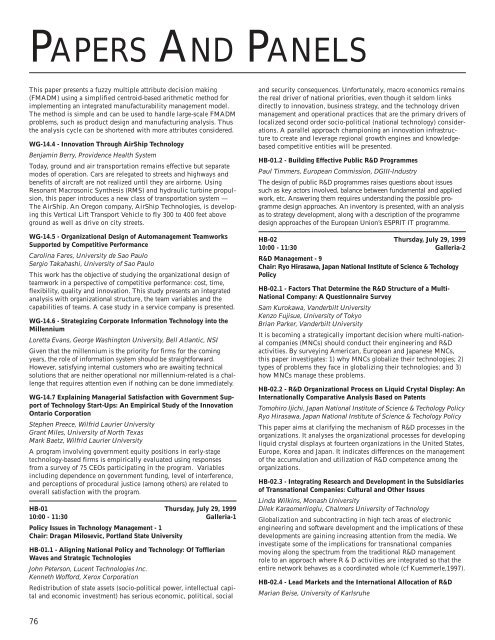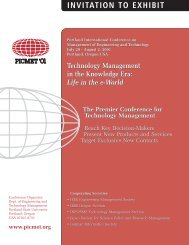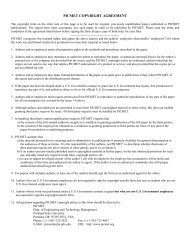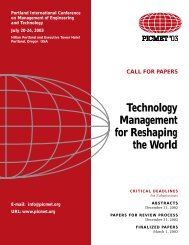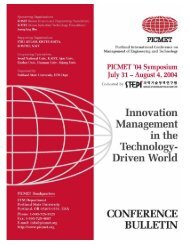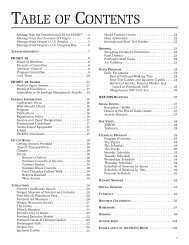Technology & Innovation Management: - PICMET Conference
Technology & Innovation Management: - PICMET Conference
Technology & Innovation Management: - PICMET Conference
You also want an ePaper? Increase the reach of your titles
YUMPU automatically turns print PDFs into web optimized ePapers that Google loves.
PAPERS AND PANELS<br />
This paper presents a fuzzy multiple attribute decision making<br />
(FMADM) using a simplified centroid-based arithmetic method for<br />
implementing an integrated manufacturability management model.<br />
The method is simple and can be used to handle large-scale FMADM<br />
problems, such as product design and manufacturing analysis. Thus<br />
the analysis cycle can be shortened with more attributes considered.<br />
WG-14.4 - <strong>Innovation</strong> Through AirShip <strong>Technology</strong><br />
Benjamin Berry, Providence Health System<br />
Today, ground and air transportation remains effective but separate<br />
modes of operation. Cars are relegated to streets and highways and<br />
benefits of aircraft are not realized until they are airborne. Using<br />
Resonant Macrosonic Synthesis (RMS) and hydraulic turbine propulsion,<br />
this paper introduces a new class of transportation system —<br />
The AirShip. An Oregon company, AirShip Technologies, is developing<br />
this Vertical Lift Transport Vehicle to fly 300 to 400 feet above<br />
ground as well as drive on city streets.<br />
WG-14.5 - Organizational Design of Automanagement Teamworks<br />
Supported by Competitive Performance<br />
Carolina Fares, University de Sao Paulo<br />
Sergio Takahashi, University of Sao Paulo<br />
This work has the objective of studying the organizational design of<br />
teamwork in a perspective of competitive performance: cost, time,<br />
flexibility, quality and innovation. This study presents an integrated<br />
analysis with organizational structure, the team variables and the<br />
capabilities of teams. A case study in a service company is presented.<br />
WG-14.6 - Strategizing Corporate Information <strong>Technology</strong> into the<br />
Millennium<br />
Loretta Evans, George Washington University, Bell Atlantic, NSI<br />
Given that the millennium is the priority for firms for the coming<br />
years, the role of information system should be straightforward.<br />
However, satisfying internal customers who are awaiting technical<br />
solutions that are neither operational nor millennium-related is a challenge<br />
that requires attention even if nothing can be done immediately.<br />
WG-14.7 Explaining Managerial Satisfaction with Government Support<br />
of <strong>Technology</strong> Start-Ups: An Empirical Study of the <strong>Innovation</strong><br />
Ontario Corporation<br />
Stephen Preece, Wilfrid Laurier University<br />
Grant Miles, University of North Texas<br />
Mark Baetz, Wilfrid Laurier University<br />
A program involving government equity positions in early-stage<br />
technology-based firms is empirically evaluated using responses<br />
from a survey of 75 CEOs participating in the program. Variables<br />
including dependence on government funding, level of interference,<br />
and perceptions of procedural justice (among others) are related to<br />
overall satisfaction with the program.<br />
HB-01 Thursday, July 29, 1999<br />
10:00 - 11:30 Galleria-1<br />
Policy Issues in <strong>Technology</strong> <strong>Management</strong> - 1<br />
Chair: Dragan Milosevic, Portland State University<br />
HB-01.1 - Aligning National Policy and <strong>Technology</strong>: Of Tofflerian<br />
Waves and Strategic Technologies<br />
John Peterson, Lucent Technologies Inc.<br />
Kenneth Wofford, Xerox Corporation<br />
Redistribution of state assets (socio-political power, intellectual capital<br />
and economic investment) has serious economic, political, social<br />
and security consequences. Unfortunately, macro economics remains<br />
the real driver of national priorities, even though it seldom links<br />
directly to innovation, business strategy, and the technology driven<br />
management and operational practices that are the primary drivers of<br />
localized second order socio-political (national technology) considerations.<br />
A parallel approach championing an innovation infrastructure<br />
to create and leverage regional growth engines and knowledgebased<br />
competitive entities will be presented.<br />
HB-01.2 - Building Effective Public R&D Programmes<br />
Paul Timmers, European Commission, DGIII-Industry<br />
The design of public R&D programmes raises questions about issues<br />
such as key actors involved, balance between fundamental and applied<br />
work, etc. Answering them requires understanding the possible programme<br />
design approaches. An inventory is presented, with an analysis<br />
as to strategy development, along with a description of the programme<br />
design approaches of the European Union’s ESPRIT IT programme.<br />
HB-02 Thursday, July 29, 1999<br />
10:00 - 11:30 Galleria-2<br />
R&D <strong>Management</strong> - 9<br />
Chair: Ryo Hirasawa, Japan National Institute of Science & Techology<br />
Policy<br />
HB-02.1 - Factors That Determine the R&D Structure of a Multi-<br />
National Company: A Questionnaire Survey<br />
Sam Kurokawa, Vanderbilt University<br />
Kenzo Fujisue, University of Tokyo<br />
Brian Parker, Vanderbilt University<br />
It is becoming a strategically important decision where multi-national<br />
companies (MNCs) should conduct their engineering and R&D<br />
activities. By surveying American, European and Japanese MNCs,<br />
this paper investigates: 1) why MNCs globalize their technologies; 2)<br />
types of problems they face in globalizing their technologies; and 3)<br />
how MNCs manage these problems.<br />
HB-02.2 - R&D Organizational Process on Liquid Crystal Display: An<br />
Internationally Comparative Analysis Based on Patents<br />
Tomohiro Ijichi, Japan National Institute of Science & Techology Policy<br />
Ryo Hirasawa, Japan National Institute of Science & Techology Policy<br />
This paper aims at clarifying the mechanism of R&D processes in the<br />
organizations. It analyses the organizational processes for developing<br />
liquid crystal displays at fourteen organizations in the United States,<br />
Europe, Korea and Japan. It indicates differences on the management<br />
of the accumulation and utilization of R&D competence among the<br />
organizations.<br />
HB-02.3 - Integrating Research and Development in the Subsidiaries<br />
of Transnational Companies: Cultural and Other Issues<br />
Linda Wilkins, Monash University<br />
Dilek Karaomerlioglu, Chalmers University of <strong>Technology</strong><br />
Globalization and subcontracting in high tech areas of electronic<br />
engineering and software development and the implications of these<br />
developments are gaining increasing attention from the media. We<br />
investigate some of the implications for transnational companies<br />
moving along the spectrum from the traditional R&D management<br />
role to an approach where R & D activities are integrated so that the<br />
entire network behaves as a coordinated whole (cf Kuemmerle,1997).<br />
HB-02.4 - Lead Markets and the International Allocation of R&D<br />
Marian Beise, University of Karlsruhe<br />
76


